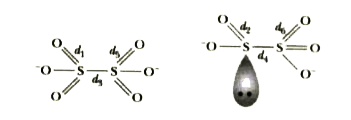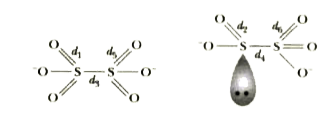Hybrid orbital with least s- character is
sp
The correct Answer is:A
To determine which hybrid orbital has the least s-character, we need to analyze the s-character of each given hybrid orbital: sp3d, sp2, sp3, and sp. Here’s a step-by-step breakdown:
Step 1: Identify the Hybrid Orbitals
The hybrid orbitals we need to analyze are:
- sp3d
- sp2
- sp3
- sp
Step 2: Calculate the s-character for each hybrid orbital
1. sp3d Hybridization:
- Participating orbitals: 1s + 3p + 1d = 5 orbitals
- s-character = (Number of s orbitals / Total orbitals) × 100
- s-character = (1 / 5) × 100 = 20%
2. sp2 Hybridization:
- Participating orbitals: 1s + 2p = 3 orbitals
- s-character = (1 / 3) × 100 = 33.33%
3. sp3 Hybridization:
- Participating orbitals: 1s + 3p = 4 orbitals
- s-character = (1 / 4) × 100 = 25%
4. sp Hybridization:
- Participating orbitals: 1s + 1p = 2 orbitals
- s-character = (1 / 2) × 100 = 50%
Step 3: Compare the s-character values
Now we can summarize the s-character percentages for each hybrid orbital:
- sp3d: 20%
- sp2: 33.33%
- sp3: 25%
- sp: 50%
Step 4: Determine the hybrid orbital with the least s-character
From the calculated values, we can see that:
- The hybrid orbital with the least s-character is sp3d with 20% s-character.
Conclusion
The hybrid orbital with the least s-character is sp3d.
---
The hybrid orbitals we need to analyze are:
- sp3d
- sp2
- sp3
- sp
1. sp3d Hybridization:
- Participating orbitals: 1s + 3p + 1d = 5 orbitals
- s-character = (Number of s orbitals / Total orbitals) × 100
- s-character = (1 / 5) × 100 = 20%
- Participating orbitals: 1s + 2p = 3 orbitals
- s-character = (1 / 3) × 100 = 33.33%
- Participating orbitals: 1s + 3p = 4 orbitals
- s-character = (1 / 4) × 100 = 25%
- Participating orbitals: 1s + 1p = 2 orbitals
- s-character = (1 / 2) × 100 = 50%
Now we can summarize the s-character percentages for each hybrid orbital:
- sp3d: 20%
- sp2: 33.33%
- sp3: 25%
- sp: 50%
From the calculated values, we can see that:
- The hybrid orbital with the least s-character is sp3d with 20% s-character.
The hybrid orbital with the least s-character is sp3d.
Topper's Solved these Questions
- CHEMICAL BONDING AND MOLECULAR STRUCTUREBook:NARAYNAChapter:CHEMICAL BONDING AND MOLECULAR STRUCTUREExercise:CUQ (DATIVE BOND)
Explore 3 Videos
- CHEMICAL BONDING AND MOLECULAR STRUCTUREBook:NARAYNAChapter:CHEMICAL BONDING AND MOLECULAR STRUCTUREExercise:CUQ (MOLECULAR ORBITAL THEORY)
Explore 7 Videos
- CHEMICAL BONDING AND MOLECULAR STRUCTUREBook:NARAYNAChapter:CHEMICAL BONDING AND MOLECULAR STRUCTUREExercise:CUQ (VSEPR THEORY)
Explore 8 Videos
- CARBONYL COMPOUNDSBook:NARAYNAChapter:CARBONYL COMPOUNDSExercise:LEVEL -VI
Explore 99 Videos
- CHEMICAL EQUILIBRIUMBook:NARAYNAChapter:CHEMICAL EQUILIBRIUMExercise:Exercise -IV
Explore 33 Videos
Similar Questions
Ahybrid orbital has 25% s-character and 75% p-character. To which type of hybridization it belongs
View SolutionAccording to hybridisation theory, the % s-character in sp,sp2andsp3 hybrid orbitals is 50, 33.3 and 25 respectively, but this is not true for all the species. When θ is the bond angle between equivalent hybrid orbitals then % s and p-character in hybrid orbitals (when only s and p-orbitals are involved in hybridisation) can be calculated by the following formula :
cosθ=SS−1=P−1P
Q. Smallest OˆSO bond angle is found in :
View Solution
Knowledge Check
Hybrid orbital with maximum p-character is
Asp3dBsp3CspDsp3d2According to Bent's rule, more electronegative atom prefers to stay in that hybrid orbital which has less s-character and lone pair prefers to stay in that hybrid orbital which has more s-character.
Consider the molecules given below and answer the following question

Which of the following bond length order is correct?Ad1<d3Bd1=d3Cd5>d1DBoth (A) and (B)According to Bent's rule, more electronegative atom prefers to stay in that hybrid orbital which has less s-character and lone pair prefers to stay in that hybrid orbital which has more s-character.
Consider the molecules given below and answer the following question

Out of d1,d2,d3,d4,d5 and d6 which bond length is the maximum?Ad3Bd4Cd1Dd5
According to hybridisation theory, the % s-character in sp,sp2andsp3 hybrid orbitals is 50, 33.3 and 25 respectively, but this is not true for all the species. When θ is the bond angle between equivalent hybrid orbitals then % s and p-character in hybrid orbitals (when only s and p-orbitals are involved in hybridisation) can be calculated by the following formula :
cosθ=SS−1=P−1P
Q. Smallest OˆSO bond angle is found in :
View SolutionThe hybrid orbitals with 33.33% S-character are involed in the bonding of one of the crystalline allotropes of carbon. The allotrope is
View SolutionAccording to hybridisation theory, the % s-character in sp,sp2andsp3 hybrid orbitals is 50, 33.3 and 25 respectively, but this is not true for all the species. When θ is the bond angle between equivalent hybrid orbitals then % s and p-character in hybrid orbitals (when only s and p-orbitals are involved in hybridisation) can be calculated by the following formula :
cosθ=SS−1=P−1P
Q. Correct order of P−P bond length in the following compound is :
View SolutionAccording to hybridisation theory, the % s-character in sp,sp2andsp3 hybrid orbitals is 50, 33.3 and 25 respectively, but this is not true for all the species. When θ is the bond angle between equivalent hybrid orbitals then % s and p-character in hybrid orbitals (when only s and p-orbitals are involved in hybridisation) can be calculated by the following formula :
cosθ=SS−1=P−1P
Q. Correct order of P−P bond length in the following compound is :
View SolutionAccording to hybridisation theory, the % s-character in sp,sp2andsp3 hybrid orbitals is 50, 33.3 and 25 respectively, but this is not true for all the species. When θ is the bond angle between equivalent hybrid orbitals then % s and p-character in hybrid orbitals (when only s and p-orbitals are involved in hybridisation) can be calculated by the following formula :
cosθ=SS−1=P−1P
Q. Two elements X and Y combined together to form a covalent compound. If % p-character is found to be 80% in a orbital then the hybridised state of central atom X for the orbital is :
View Solution

